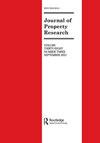城市零售中心内的物业使用多样性和空间可达性:零售租金的驱动因素
IF 2.3
Q2 URBAN STUDIES
引用次数: 6
摘要
摘要:本研究探讨了高街零售租金与投资者多样性、空间可达性的关系。高街零售业的空间定量分析仍然是一个不发达的地区,因此本文试图通过采用空间固定效应面板建模方法来弥合这一差距,并为关于城市零售中心适应性的辩论做出贡献。实证结果表明,物业使用的多样性和丰富性倾向于对零售租金价值产生显著的正向影响。所有权丰富度对租金的影响是正的,这意味着在房东类型范围更大的街道上,租金往往更高。作为衡量空间可达性的一项指标,可步行性与市场租金呈负相关。这可能令人惊讶,因为人们曾预计,零售中心最适合步行的街道连接最紧密,租金也最高。这一相反的结果可能是由于大型发展中断了街道网络,限制了行人的选择和活动。主要零售场地的位置与商店租金有显著的正相关关系,而靠近交通节点的影响则不太一致。本文章由计算机程序翻译,如有差异,请以英文原文为准。
Property use diversity and spatial accessibility within urban retailing centres: drivers of retail rents
ABSTRACT This study investigates the relationship between use and investor diversity, spatial accessibility, and high street retail rents. Spatial quantitative analysis of the high street retail sector remains an underdeveloped area so this paper seeks to bridge this gap and contribute to the debate on the adaptability of urban retailing centres by adopting a spatial fixed-effects panel modelling approach. The empirical findings reveal that diversity and richness in property use tend to have a significant positive impact on retail rental values. The influence of ownership richness on rents is positive implying that rents tend to be higher on streets where there is a greater range in the type of landlords. Walkability, as a measure of spatial accessibility, is found to have a negative relationship with market rents. This is perhaps surprising as it had been expected that the most walkable streets in retailing centres to be the most connected and have the highest rents. This contrary finding may be due to large developments interrupting the street network and restricting the choice and movement of pedestrians. Location on the prime retail pitch has a significant positive relationship with shop rents, whereas proximity to transportation nodes has a less consistent influence.
求助全文
通过发布文献求助,成功后即可免费获取论文全文。
去求助
来源期刊

Journal of Property Research
URBAN STUDIES-
CiteScore
3.80
自引率
5.30%
发文量
13
期刊介绍:
The Journal of Property Research is an international journal. The title reflects the expansion of research, particularly applied research, into property investment and development. The Journal of Property Research publishes papers in any area of real estate investment and development. These may be theoretical, empirical, case studies or critical literature surveys.
 求助内容:
求助内容: 应助结果提醒方式:
应助结果提醒方式:


